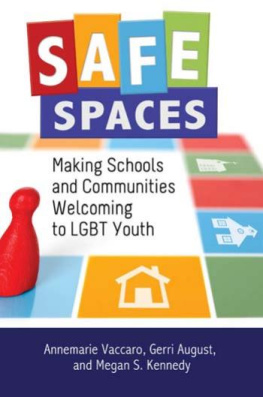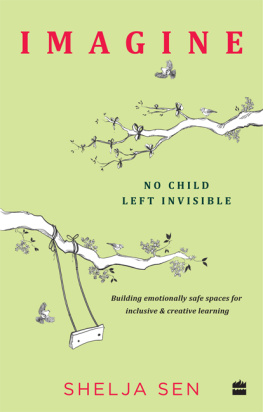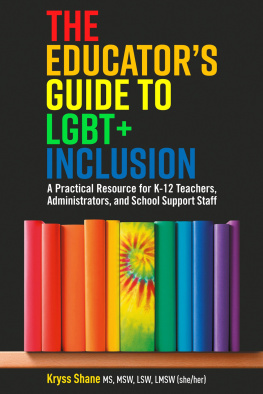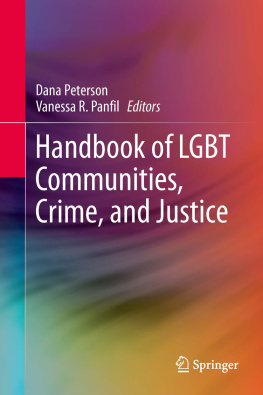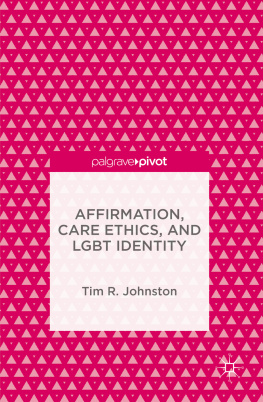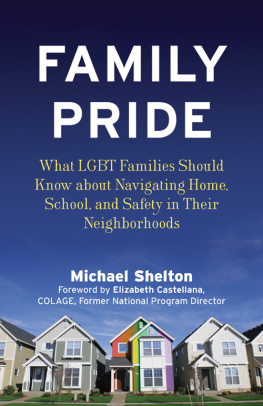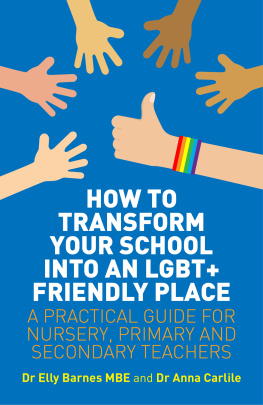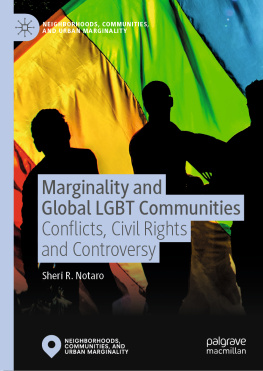Annemarie Vaccaro - Safe Spaces: Making Schools and Communities Welcoming to LGBT Youth
Here you can read online Annemarie Vaccaro - Safe Spaces: Making Schools and Communities Welcoming to LGBT Youth full text of the book (entire story) in english for free. Download pdf and epub, get meaning, cover and reviews about this ebook. year: 2011, genre: Home and family. Description of the work, (preface) as well as reviews are available. Best literature library LitArk.com created for fans of good reading and offers a wide selection of genres:
Romance novel
Science fiction
Adventure
Detective
Science
History
Home and family
Prose
Art
Politics
Computer
Non-fiction
Religion
Business
Children
Humor
Choose a favorite category and find really read worthwhile books. Enjoy immersion in the world of imagination, feel the emotions of the characters or learn something new for yourself, make an fascinating discovery.
- Book:Safe Spaces: Making Schools and Communities Welcoming to LGBT Youth
- Author:
- Genre:
- Year:2011
- Rating:3 / 5
- Favourites:Add to favourites
- Your mark:
- 60
- 1
- 2
- 3
- 4
- 5
Safe Spaces: Making Schools and Communities Welcoming to LGBT Youth: summary, description and annotation
We offer to read an annotation, description, summary or preface (depends on what the author of the book "Safe Spaces: Making Schools and Communities Welcoming to LGBT Youth" wrote himself). If you haven't found the necessary information about the book — write in the comments, we will try to find it.
Safe Spaces: Making Schools and Communities Welcoming to LGBT Youth — read online for free the complete book (whole text) full work
Below is the text of the book, divided by pages. System saving the place of the last page read, allows you to conveniently read the book "Safe Spaces: Making Schools and Communities Welcoming to LGBT Youth" online for free, without having to search again every time where you left off. Put a bookmark, and you can go to the page where you finished reading at any time.
Font size:
Interval:
Bookmark:
 SAFE SPACES This page intentionally left blank
SAFE SPACES This page intentionally left blank SAFE SPACES Making Schools and Communities Welcoming to LGBT Youth Annemarie Vaccaro, Gerri August, and Megan S. Kennedy Foreword by Barbara M. Newman
SAFE SPACES Making Schools and Communities Welcoming to LGBT Youth Annemarie Vaccaro, Gerri August, and Megan S. Kennedy Foreword by Barbara M. Newman  Copyright 2012 by Annemarie Vaccaro, Gerri August, and Megan S. Kennedy All rights reserved. No part of this publication may be reproduced, stored in a retrieval system, or transmitted, in any form or by any means, electronic, mechanical, photocopying, recording, or otherwise, except for the inclusion of brief quotations in a review, without prior permission in writing from the publisher. Library of Congress Cataloging-in-Publication Data Vaccaro, Annemarie.
Copyright 2012 by Annemarie Vaccaro, Gerri August, and Megan S. Kennedy All rights reserved. No part of this publication may be reproduced, stored in a retrieval system, or transmitted, in any form or by any means, electronic, mechanical, photocopying, recording, or otherwise, except for the inclusion of brief quotations in a review, without prior permission in writing from the publisher. Library of Congress Cataloging-in-Publication Data Vaccaro, Annemarie.
Safe spaces : making schools and communities welcoming to LGBT youth / Annemarie Vaccaro, Gerri August, and Megan S. Kennedy ; foreword by Barbara M. Newman. p. cm. Includes bibliographical references and index.
ISBN 9780313393686 (hardback : acid-free paper) ISBN 9780313393693 (ebook) 1. Sexual minority youthUnited States. 2. Sexual minority youthPsychologyUnited States. 3. 4. 4.
Public schoolsSocial aspectsUnited States. I. August, Gerri. II. Kennedy, Megan S. Title. Title.
HQ76.27.Y68V33 2012 306.760608350973dc23 2011033278 ISBN: 9780313393686 EISBN: 9780313393693 16 15 14 13 12 1 2 3 4 5 This book is also available on the World Wide Web as an eBook. Visit www.abc-clio.com for details. Praeger An Imprint of ABC-CLIO, LLC ABC-CLIO, LLC 130 Cremona Drive, P.O. Box 1911 Santa Barbara, California 93116-1911 This book is printed on acid-free paper Manufactured in the United States of America We dedicate this book to LGBT youth who persevere, and even thrive, despite sometimes overwhelming tides of homophobia, transphobia, genderism, and heterosexism. We also salute youth and adult allies who work tirelessly to make our schools and communities safe spaces. This page intentionally left blank Contents This page intentionally left blank As a professor of human development and the co-author with my husband Phil of Development Through Life, a lifespan text that is in its 11th edition, I have been reading, writing, and teaching about gender-related themes for quite some time.
The field has been slow to consider the systematic unfolding of sexual orientation. Despite Freuds early theorizing about the sexual nature of children, research and theory about the emergent nature of sexual fantasies, desires, or behaviors, whether self- or other-focused, is far less developed than the research and theory about gender. Parents are famously uncommunicative about sexuality; educators are ill-prepared to teach children and youth about their sexuality; and political controversies swarm around communities, resulting in cautious, minimal teaching or deliberate exclusion of this topic altogether. Many children are left to figure things out for themselves through movies, websites, books they can find at the library, and gossip. Imagine if we had so little to say about which foods were safe to eat and how to prepare foods to make them taste delicious. Imagine if we had so little to say about dental hygiene and the importance of brushing and flossing.
Yet here we are in the twenty-first century, tongue-tied about sexuality. The culture is chaotically divided in its approach to sexuality. On the one hand, children and youth are exposed to media images of sexual encoun ters, ads for products intended to enhance sexual performance, music and videos from sexually suggestive performers, and erotic magazines, websites, and movies. On the other hand, there are relatively few environments where children and youth can talk freely about their own sexual experien ces and learn about how to express their sexual impulses in ways that are pleasurable, physically safe, and, when appropriate, responsive to their sex ual partners. As a result, many children and youth arrive at adulthood in a state of confusion: their personal identity is disconnected from their sexual selves. This leads to a variety of social harms, including self-loathing, vul nerability to sexual predators, unsafe sexual practices, sexual aggression, x Foreword sexual stigmatization, sexual harassment, and prejudice against those who appear to have a non-normative sexual preference.
In my opinion, we have failed to create a safe space for children to learn about their sexual natures and to be accepting of the diverse pathways and preferences of the sexual motivation and behaviors of others. Annemarie Vaccaro, Gerri August, and Megan Kennedy shared a vision for a project that would address this failure with a particular focus on les bian, gay, bisexual, and transgender youth. They recognized the need to support LGBT youth as they function in their everyday lives across time and spacethat is, from childhood into the college years, and from family to school and community settings. Safe Spaces starts from where we are nowacknowledging the challenges that LGBT youth continue to face and the many voices in communities across the country that marginal ize and vilify them and threaten their futures. The book uncovers evidence of support, innovation, and power in LGBT youth themselves as well as their allies. As you read, you will hear many voicesvoices of children, youth, college students, parents, teachers, com munity leaders, scholars, and politicians.
The sense is that there is an active, dynamic dialogue taking place, sometimes openly in kitchens, classrooms, libraries (ever so quietly), youth organizations, and community centers; and sometimes in the hidden corners of bathrooms, locker rooms, parking lots, and websites. The book envisions a more secure, supportive, and accepting future for LGBT youth, and guides us as we strive to achieve this future by describing role models, sharing the courage of children and youth themselves, and giving us a wide palette of strategies for creating safe spaces wherever we can. As a reader, I was reminded of my own reactions to the first couple who came out to me as lesbian partners many years ago. I disappointed them with my reaction; I was both surprised and shocked. But little did they know that in trusting me with their truth, they prepared me to be more accepting and encouraging when one of my sons and my daughter came out. Our childrearing philosophy was heavily influenced by the work on gender that was taking place during the 1970s, and if you could summarize our outlook, it was captured in the album Free to Be You and Me.
We cher ished creativity, individuality, and freedom of expression, and we saw each of our children blossom into a young person with tremendous talents, a generous spirit, and a love of life. Unfortunately, the album and the prevail ing gender narrative left out some important ideas about sexual orienta tion, so we werent as prepared for some aspects of Free to Be as we might Foreword xi have been. Nonetheless, communication was open, affection was deep, and we have a delightfully diverse family. We are hoping for at least one queer grandchild. So it is with great relief and optimism that I welcome Safe Spaces and commend it to you as readers. If it is possible for a book to be a safe space in its own right, this is such a book.
Despite the bigotry and discrimination that many LGBT youth and their allies face, the authors strike a hopeful tone. They ask us as readers to reflect on our thoughts, feelings, behaviors, and beliefs and to consider taking action in the domains where we may have an impacthome, school, university, and community. The book is inclusive, both in its consideration of the wide range of people who might serve as allies, and in its consideration of the diversity of LGBT youth. And the book is constructive, offering many ideas about how to enrich set tings for young people so that they always experience a sense of belonging as they carry out the work of forming their sexual and gender identities. Safe Spaces is an important contribution to the construction of a more open, supportive environment in which all children and youth can address the cognitive, emotional, and social nature of their own sexuality and the sexuality of others. Barbara M.
Next pageFont size:
Interval:
Bookmark:
Similar books «Safe Spaces: Making Schools and Communities Welcoming to LGBT Youth»
Look at similar books to Safe Spaces: Making Schools and Communities Welcoming to LGBT Youth. We have selected literature similar in name and meaning in the hope of providing readers with more options to find new, interesting, not yet read works.
Discussion, reviews of the book Safe Spaces: Making Schools and Communities Welcoming to LGBT Youth and just readers' own opinions. Leave your comments, write what you think about the work, its meaning or the main characters. Specify what exactly you liked and what you didn't like, and why you think so.

